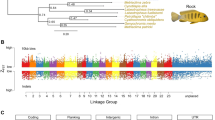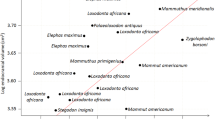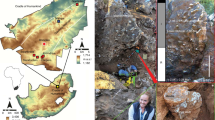Abstract
Replying to G. Mayer, C. Martin, I. S. Oliveira, F. A. Franke & V. Gross Nature 516, 10.1038/nature13860 (2014)
In the accompanying Comment Mayer et al.1 dispute ancestral affinities of Lyrarapax unguispinus and onychophoran brains. Here, we contest their claim that the evolutionary scenario described in Cong et al.2 is unviable.
This is a preview of subscription content, access via your institution
Access options
Subscribe to this journal
Receive 51 print issues and online access
$199.00 per year
only $3.90 per issue
Buy this article
- Purchase on Springer Link
- Instant access to full article PDF
Prices may be subject to local taxes which are calculated during checkout

Similar content being viewed by others
References
Mayer, G., Martin, C., Oliveira, I. S., Franke, F. A. & Gross, V. Latest anomalocaridid affinities challenged. Nature 516, http://dx.doi.org/10.1038/nature13860 (2014)
Cong, P., Ma, X., Hou, X., Edgecombe, G. D. & Strausfeld, N. J. Brain structure resolves the segmental affinity of anomalocaridid appendages. Nature 513, 538–542 (2014)
Strausfeld, N. J., Strausfeld, C. M., Stowe, S., Rowell, D. & Loesel, R. The organization and evolutionary implications of neuropils and their neurons in the brain of the onychophoran Euperipatoides rowelli. Arthropod Struct. Dev. 35, 169–196 (2006)
Eriksson, B. J. & Budd, G. E. Onychophoran cephalic nerves and their bearing on our understanding of head segmentation and stem-group evolution of Arthropoda. Arthropod Struct. Dev. 29, 197–209 (2000)
Eriksson, B. J., Tait, N. N. & Budd, G. E. Head development in the onychophoran Euperipatoides kanangrensis with particular reference to the central nervous system. J. Morphol. 255, 1–23 (2003)
Treffkorn, S. & Mayer, G. Expression of the decapentaplegic ortholog in embryos of the onychophoran Euperipatoides rowelli. Gene Expr. Patterns 13, 384–394 (2013)
Mayer, G. & Harzsch, S. Immunolocalization of serotonin in Onychophora argues against segmental ganglia being an ancestral feature of arthropods. BMC Evol. Biol. 7, 118 (2007)
Mayer, G., Whitington, P. M., Sunnucks, P. & Pfluger, H. J. A revision of brain composition in Onychophora (velvet worms) suggests that the tritocerebrum evolved in arthropods. BMC Evol. Biol. 10, 255 (2010)
Smith, M. R. & Ortega-Hernández, J. Hallucigenia’s onychophoran-like claws and the case for Tactopoda. Nature 514, 363–366 (2014)
Kennel von, J. Entwicklungsgeschichte von Peripatus edwardsii Blanch. und Peripatus torquatus n. sp. Arch. Zool.-Anat. Inst. Würzburg 8, 1e93 (1888)
Sedgwick, A. Peripatus (Macmillan, 1922)
Oliveira, M. B. et al. Expression of arthropod distal limb-patterning genes in the onychophoran Euperipatoides kanangrensis. Dev. Genes Evol. 224, 87–96 (2014)
Sombke, A., Harzsch, S. & Hansson, B. S. Organization of deutocerebral neuropils and olfactory behavior in the centipede Scutigera coleoptrata (Linnaeus, 1758) (Myriapoda: Chilopoda). Chem. Senses 36, 43–61 (2011)
Author information
Authors and Affiliations
Corresponding authors
PowerPoint slides
Rights and permissions
About this article
Cite this article
Cong, P., Ma, X., Hou, X. et al. Cong et al. reply. Nature 516, E3–E4 (2014). https://doi.org/10.1038/nature13861
Published:
Issue Date:
DOI: https://doi.org/10.1038/nature13861
This article is cited by
-
The velvet worm brain unveils homologies and evolutionary novelties across panarthropods
BMC Biology (2022)
-
The functional head of the Cambrian radiodontan (stem-group Euarthropoda) Amplectobelua symbrachiata
BMC Evolutionary Biology (2017)
Comments
By submitting a comment you agree to abide by our Terms and Community Guidelines. If you find something abusive or that does not comply with our terms or guidelines please flag it as inappropriate.



